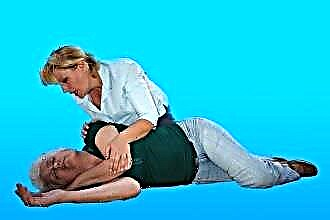Fainting (syncope) is a short-term state of loss of consciousness, lasting from a few seconds to 1-2 minutes. It occurs as a result of a temporary deterioration in cerebral blood flow.
Why does a person faint?
| Causes of syncope | |
|---|---|
| Decreased circulating blood volume |
|
| Decreased heart output |
|
| Impaired nervous regulation (through increased intrathoracic pressure) |
|
| Decreased blood oxygen |
|
| Increased blood pressure (BP) in the vessels of the brain (intracranial) |
|
| Other |
|
With increased pressure
 Loss of consciousness at high blood pressure is quite common. It mainly occurs in persons suffering from arterial hypertension with the next sharp rise in blood pressure (hypertensive crisis).
Loss of consciousness at high blood pressure is quite common. It mainly occurs in persons suffering from arterial hypertension with the next sharp rise in blood pressure (hypertensive crisis).
In such a case, the vessels are spasmodic, which sharply reduces the flow of blood to the heart and brain, and it is the carrier of oxygen, which is necessary for the normal functioning of the body and its stay in clear consciousness. So it turns out, in order to prevent its lack and reduce muscle spasm, the body turns on the defense mechanism and falls into unconsciousness, since in a horizontal position circulation improves and the person soon regains consciousness.
It is difficult to determine the exact pressure indicators at which the loss of consciousness will occur, since they are individual for each and depend on the personal "norm".
 The most common parameters at which fainting occurs:
The most common parameters at which fainting occurs:
- 140/90 mm. rt. Art. - for women;
- 160/100 mm. - for men;
- in people who do not suffer from hypertension - a rise of 20/10 mm. Art.
Symptoms by which you can recognize and prevent loss of consciousness at high blood pressure:
- headache of a pressing or throbbing character;
- feeling of a rush of blood to the head;
- noise in ears;
- fast heartbeat;
- weakness;
- sweating;
- numbness of the limbs, "wobbling of the legs";
- chills.
When the pressure drops
Some healthy people, as well as with various diseases, have a sharp drop in blood pressure and fainting. The mechanism of occurrence is based on acute vascular insufficiency. Due to a decrease in vascular tone and blood pressure, blood flow to the brain decreases, which leads to syncope.
 The lower indicators, at which loss of consciousness often occurs:
The lower indicators, at which loss of consciousness often occurs:
- 90/60 mm. - for women;
- 100/60 mm. - for men.
Symptoms by which you can recognize low blood pressure and prevent fainting:
- nausea;
- chills;
- tinnitus;
- numbness of hands and feet;
- dizziness;
- weakness;
- bowing of the legs;
- sweating
When do they often lose consciousness?
More often syncope occurs with low blood pressure, especially in patients with VSD. It is recommended for such people:
- drink tea or coffee every day;
- quit smoking and drinking alcohol;
- full sleep;
- swimming, walking;
- meals 5-6 times a day.
Giving help
Algorithm for helping an unconscious patient:
 If possible, try to support the person in order to avoid injury due to the fall.
If possible, try to support the person in order to avoid injury due to the fall.- Laying the person on their side will help keep the airway open.
- Raise your legs if possible.
- Free the victim from tight clothing.
- Sprinkle water over your face, rub your ears and cheeks.
- Bring the ammonia to your nose.
- Determine the indicators of the pulse and pressure of the patient.
- If the above steps did not help, call an ambulance.
How can syncope be prevented?
- Lead a healthy lifestyle.
- Get rid of bad habits.
- Avoid stress.
- Do not move to a sitting or standing position too quickly and abruptly.
- Do physical education.
- Sit down or lie down with legs raised if you feel light-headed. Unbutton your clothes. Wash with water. Eat something sweet.
- If high blood pressure is defined as a common cause of fainting, then it is necessary to take pills prescribed by a doctor to reduce it or seek medical help. Prescribing drugs on your own and adjusting their dose can be dangerous, as they can dramatically reduce blood pressure.
If the underlying disease is identified as the cause of syncope, treatment should be taken seriously.
Conclusions
As we can see, high and low pressure fainting is a common problem. In general, syncope does not lead to bad consequences, but it is an extremely unpleasant condition. Often, afterwards, people feel tired and fatigued. If the loss of consciousness lasts more than 5 minutes, seizures may develop. In this case, it is necessary to distinguish convulsive syndrome due to ordinary fainting from an epileptic seizure, since these are two completely different conditions that require different treatment.

 If possible, try to support the person in order to avoid injury due to the fall.
If possible, try to support the person in order to avoid injury due to the fall.

